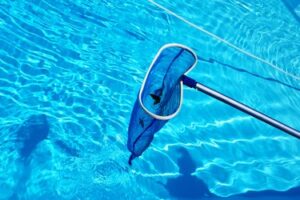 Sometimes, an above-ground pool can appear to be in very bad shape, when in reality it just needs a good cleaning, both through mechanical, hand-cleaning methods and through the use of pool chemicals, such as pool shock, algae guard, water clarifier and chlorine. These chemicals are your main defenses against most pool wreckers like algae, brown slime, and cloudy water. Check your pool’s chemical levels often to maintain the correct balance.
Sometimes, an above-ground pool can appear to be in very bad shape, when in reality it just needs a good cleaning, both through mechanical, hand-cleaning methods and through the use of pool chemicals, such as pool shock, algae guard, water clarifier and chlorine. These chemicals are your main defenses against most pool wreckers like algae, brown slime, and cloudy water. Check your pool’s chemical levels often to maintain the correct balance.
A pool skimmer, pool hose and brush, and a clean filter are your best ways of keeping the pool clean and ready for swimming. These items remove leaves, bugs, fine sediment, dirt, and other debris which will inevitably enter your pool. By spending the time and effort, your swimming pools will be sparkling clean and welcoming, and will remain so.
There are also pool vacuums available designed especially for use on above-ground pools. These are self-contained units, often battery powered, that don’t require connection to a pool filtration system. They do an excellent job of cleaning sand, sediment, and fine debris from the bottom of the pool. Some are also designed to vacuum the sides of the pool.
Step 1
Remove the pool cover, if it has one. If there’s an accumulation of dirty water lying on the cover, siphon as much of the water off before attempting to remove the cover.
Step 2
Use a pool skimmer to remove large debris from the pool’s water. This will help prevent the pool filter from clogging. Skim any floating items from the top of the water surface. Then stir up the water and skim as much of the leaves and other larger debris as you can from the bottom of the pool.
Step 3
- Remove the pool filter from its canister, and clean it inside and out with a garden hose and spray nozzle. Saturate the filter fully with water. If the filter is so dirty it cannot be cleaned, you’ll need to replace it.
- Reinstall the pool filter into the canister of the pool pump. Make sure the filter is installed properly and that the cover is tightly sealed.
- Connect the pump and filter to the pool and let the pool water flow through your filtering system. When ready, turn on the pool pump.
Step 4
Clean the pool bottom, slowly and in sections, using a pool brush or vacuum. If using a brush, your goal is to agitate the water so that the pool’s water so the filtration system can remove some of the particulate debris. It’s better, though, to use a pool vacuum:
Step 5
- Connect the vacuum pole and attach it to the vacuum head, as directed by the manufacturer.
- Attach the hose to the apparatus, making sure to remove all air from the hose by flooding it with water.
- Submerge the vacuum head and follow the manufacturer’s method to clean the bottom and sides of your pool. While vacuuming up debris from the floor of the pool, scrub stained areas thoroughly, but be gentle to make sure the liner does not rip. Do not expect to remove all stains; it is expected that some may remain.
- When cleaning a pool that’s been neglected, the filters on the pool vacuum will likely fill up several times during the cleaning. Pause to clean out the vacuum’s filter whenever it becomes full. On some vacuums, this is a simple removable basket filter, while on others is a cartridge filter that must be popped out to clean. Whatever type filter is used, remove it from the canister to clean it thoroughly with fresh water.
- Repeat until the pool bottom is clean and the vacuum filter produces very little debris. Remove the vacuum and hose from the pool.
Step 6
Now, add double the amount of pool shock, algae guard and water clarifier that is normally required for the gallon capacity of your pool. Read the package instructions to determine the exact measurements. By doubling up, you’re be blasting the water in a manner that will kill accumulated bacteria and algae. This should quickly clear up water that is cloudy.
- First, slowly sprinkle a package or scoop of powdered shock around the edges of the pool. If you pour out the shock too quickly, it may simply pile up on the bottom of the pool, so go slowly. If it does accumulate on the bottom, use a pool brush to stir up it up and distribute it in the water. If you leave the powder sitting in one place, the shock will bleach the bottom of the pool liner.
- Next, add the water clarifier by distributing it around the edge of the pool. Stir the water with the pool brush, if necessary, to mix the clarifier with the pool water.
- Finally, add the algae guard in the same manner as you did the clarifier. Monitor the pool for 15 minutes to make sure no chemicals sink to the bottom. If they do, stir them up with the pool brush.
Step 7
If it’s breezy or windy out, cover the pool with a solar blanket or other cover to keep debris out of the pool. Let the pool filter run overnight.
Step 8
After the pool filter has run overnight, remove the pool cover. Use a pool chemical test strip to test the water, following manufacturer’s directions. After the rigorous chemical application from the day before, the chemical levels should be at the higher end of the scale when the test strip is compared to the color chart on the test kit’s container. If necessary, add additional chemicals to balance the pH and alkalinity levels.
If the pool was in very bad shape and has not responded to the chemical treatment, it’s possible you will need to add more chemicals, again at double doses. It is important not to swim in the water until it appears clean and until the water chemicals test at stable levels.
Step 9
Repeat this cleaning process daily of mechanical cleaning and chemical testing and treatment until the pool water is crystal clear. Cleaning time depends on the amount of debris and dirt that were originally in the pool. Pools in very poor shape may require three or more days of this treatment.
Step 10
Once the pool water is clear and the chemical levels are stable, install and fill the pool’s floating chlorine dispenser with a chlorine tablet. This will gradually distribute a consistent amount of chlorine into the pool to help keep it clean. Keep the container full the entire swimming season. During hot weather and high usage of the pool, tablets in the dispenser may dissolve at a faster rate.
